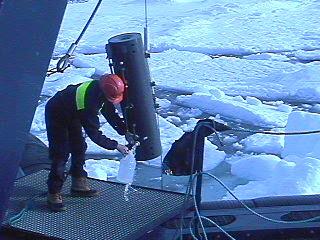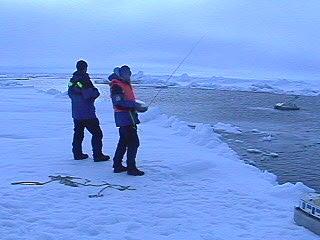
|
|
10 August, 2001
Of Bears and Men
Friday, 10 August 2001
Valkommen!
Life on Board After our 9 am Go-Flow seawater sample (My official job now
for these easy surface samples is to run the big A-Frame on the aft deck
for the CTD team), I got the chance to go out on a snowmobile run with our
gun instructor and security team member, Anders Gejer. The purpose of this
trip was twofold: First, Anders wanted to scout downwind of the ship to
look for bear signs, and second, I was to look for an open water lead where
Johan Knulst could launch his surface layer sampling boat. I asked him at
breakfast if there were any new specifications for the sampling site that
he wanted me to check for and he replied, "No bears." The other security
officer, PO Edvinsson, and our expedition leader from the Swedish Polar
Research Secretariat, Ulf Hedman, went out on skis on the upwind side of
the boat to make sure the bear had really left the area. Out on our
snowmobile run, we found a good open water lead for Johan then Anders
stopped the snowmobile and listened in his headphones. "They woke up the
bear," he said, laughing.
Where Are We Now?
We woke up to a cloudy, windless day. Light fog mixed with light snow made
a completely gray, flat, featureless landscape most of the day. Early in
the afternoon, a light wind came up, adding to the dreariness of the day.
At 11 am our coordinates were 88o35' N by 3o34' E.
Scientists at Work
A polar bear can ruin your whole day. After breakfast this morning, Mike
Jenson walked his balloon out from its hangar on the helideck to his huts
on the ice and the meteorological guys walked out to the Main Mast to work.
The polar bear reconnaissance skiers had just left on their rounds.
Apparently, they skied around the sleeping bear before they were aware of
its presence. Finding themselves with a polar bear between them and the
ship, they tried to sneak past it to return to the ship but ended up waking
it up. This was the same big bear that had visited us yesterday. I guess
it hadn't wandered off, but just had found a comfy snow hollow to sleep in.
Shortly after we returned from scouting, our visiting bear, awake and
refreshed, was walking around again and the call went out that the
scientists had to come back in. Mike didn't want to leave his balloon
tethered to the winch out at the ice camp because it might be extremely
interesting to a bear, so he walked it back in and put it back in its
hangar. The meteorological crew was recalled, too, so everybody ended up
back on the ship. The expedition leaders are being very careful to ensure
the safety of everyone onboard as well as the safety of the Arctic wildlife.
About 1 pm, we heard that the bear was coming closer to the ship so
everybody went out on the decks to watch. The bear was on the opposite
side of the ship from the ice camps and it made a really big, lazy circle
around the back end of the ship and meandered towards the ice camps with
all of their equipment. I was taking a video out on Deck 4 when the ship
suddenly blew the REALLY LOUD foghorn to try to scare the bear away. Yikes!
The bear started running and I almost did, too. It only ran a few paces
then turned again to check out all of that interesting equipment. At this
point, the helicopter team went into action and they were flying within a
few minutes.
After the helicopter helped the bear decide to find another place to hang
out, they were allowing scientists back on the ice with the warning that
they might have to leave their equipment if it comes back into the area
(Our security team said it is a really slow bear so they would have plenty
of warning). Johan Knulst (Sweden), Jussi Paatero (Finland), Brian
Thompson (U.S.), and I (U.S.) loaded up the snowmobiles with both surface
sampling boats and had the security team take us out to an open lead about
a kilometer away. We ran both boats for a couple of hours, collecting
surface layer samples automatically in bottles on each boat as they skim
the surface of the water. Unfortunately, when Johan was lifting the small
boat out of the water, its full sample bottle hit the edge of the ice and
slipped out of the holder, falling 4 kilometers to the bottom of the Arctic
Ocean. The hazards of science in the Arctic!
Vi ses! (See you later!)
From Deck 4 on the Icebreaker Oden, drifting far away,
Dena Rosenberger

Paty Matrai taking a seawater sample from the Go-Flow bottle on the aft deck.

That's me at the surface sampler controls while Brian Thompson looks on. We have to wear life jackets whenever working near an ice edge. It looks like we are just standing by a river but it is actually 4 kilometers deep (about two and a half miles).
Contact the TEA in the field at
.
If you cannot connect through your browser, copy the
TEA's e-mail address in the "To:" line of
your favorite e-mail package.
|
